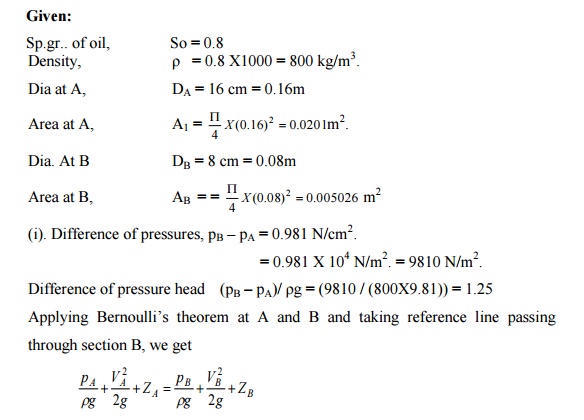Chapter: Civil : Mechanics Of Fluids : Flow Through Pipes
Bernoulli's theorem for steady flow of an incompressible fluid
Assumptions made in the derivation of
Bernoulli's equation
(i).
The fluid is ideal, i.e., Viscosity is zero.
(ii). The flow is steady
(iii).
Te flow is incompressible. (iv).
The flow is irrotational.
Bernoulli's theorem for steady flow of an incompressible
fluid.
It states that in a steady, ideal flow
of an incompressible fluid, the total energy at any point of the fluid is
constant. The total energy consists of pressure energy, kinetic
energy
and potential energy or datum energy. These energies per unit weight of the
fluid
are:
Pressure
Energy = p
/ ?g
Kinetic
energy = v2
/ 2g
Datum
Energy = z
The mathematically, Bernoulli's
theo
(p/w)
+ (v2 / 2g) + z = Constant.
Problem 1
Water is flowing through a pipe of 5 cm
diameter under a pressure of 29.43 N/cm2
(gauge)
and with mean velocity of 2.0 m/s. find the total head or total energy per unit
weight of the water at cross -section, which is 5 cm above the datum line.
Diameter of the pipe 5 cm = 0.5 m.
Pressure ? = 29.43 N/cm2 = 29.23 N/m2
` velocity, v = 2.0 m/s.
datum head z = 5 m
total head = Pressure head + Velocity head + Datum head
pressure head = (p/ ?g) 4 / (2X9=(.81)) 29=30.m43X10
kinetic head = (v2/ 2g) = ( 2X2/(2X9.81)) = 0.204 m
Total head 2
= (p/+ (v(?g))/2g)+z
= 30 + 0.204 + 5 =
35.204m
Problem
2
Water is flowing
through two different pipes, to which an inverted differential manometer having
an oil of sp. Gr 0.8 is connected the pressure head in the pipe A is 2 m of
water, find the pressure in the pipe B for the manometer readings.

Problem 3
The diameters of a pipe
at the sections 1 and 2 are 10 cm and 15 cm respectively. Find the discharge
through the pipe if the velocity of water flowing through the pipe section 1 is
5 m/s. determine also the velocity at section 2.

Problem 4
A pitot -static tube is
used to measure the velocity of water in a pipe. The stagnation pressure head
is 6mm and static pressure head is 5m. Calculate the velocity of flow assuming
the co-efficient of tube equal to 0.98.

Problem
5
A sub-marine moves
horizontally in a sea and has its axis 15 m below the surface of water. A pitot
tube properly placed just in front of the sub-marine and along its axis
connected to the two limbs of a U -tube containing mercury. The difference of
mercury level is found to be 170 mm. find the speed of the sub-marine knowing
that the sp.gr. of mercury is 13.6 and that of sea-water is 1.026 with respect
fresh

Problem 6
The water is flowing
through a pipe having diameters 20 cm and 10 cm at sections 1 and 2
respectively. The rate of flow through pipe is 35 lit/sec. the section 1 is 6m
above datum. If the pressure at section 2 is 4m above the datum. If the
pressure at section 1 is 39.24 N/cm2, find the intensity of pressure
at section 2.

Problem
7
In
a vertical pipe conveying oil of specific gravity 0.8, two pressure gauges have
been installed at A and B where the diameters are 16 cm and 8 cm respectively.
A is 2 m above B. the pressure gauge readings have shown that the pressure at B
is greater than at A by 0.981 N/cm2. Neglecting all losses, calculate the flow
rate. If the gauges at A and B are replaced by tubes filled with the same
liquid and connected to a U - tube containing mercury, calculate the difference
of level of mercury in the two limbs of the U-tube.


Related Topics